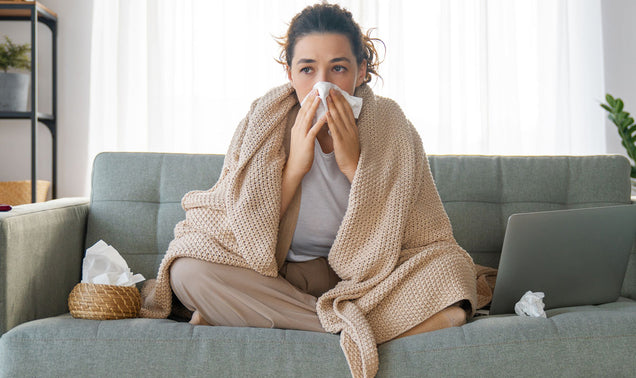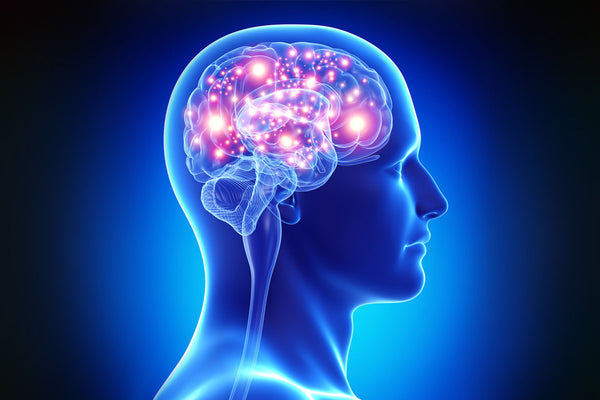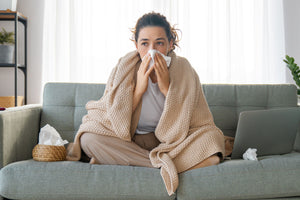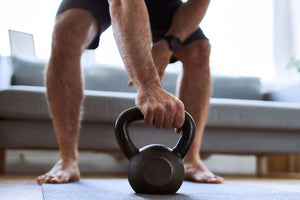What Are Endorphins?
Endorphins are the body’s natural opioids -- neuropeptides (brain proteins) involved in pain management and mood enhancement.
They’re naturally released in response to pain (e.g. breaking your arm) and obtaining certain rewards -- exercising, eating, drinking, sex, laughing, and maternal behavior.[1]
Researchers have identified ~20 different types of endorphins. The most well-researched endorphin is beta-endorphin, the feel-good chemical closely associated with the “runner’s high.”
How Do Endorphins Work?
While the end result is more or less the same -- pain relief, mood enhancement, pleasure, etc. -- the mechanism through which endorphins act is different between the central nervous system (CNS) and the peripheral nervous system (PNS).
In the CNS, endorphins bind to opioid receptors and confer their pain-relieving (analgesic) effect by inhibiting the release of GABA, the body’s main inhibitory neurotransmitter, resulting in excess production of dopamine -- a feel-good neurotransmitter involved in mood, motor control, decision-making, motivation, creativity, and pleasure.
In the Peripheral Nervous System, endorphins also bind to opioid receptors, but instead of affecting GABA, a variety of chemicals are released, including substance P, which blunt the body’s perception of pain.
What Are the Benefits of Endorphins?
Endorphins help to:
- Relieve pain
- Reduce stress
- Boost mood & well-being
- Increase pleasure
- Lessen inflammation
- Support cognitive performance
- Boost catecholamines
While endorphins are released in response to intense exercise, they may also help to prolong your ability to train hard as they can help to reduce pain, increase mood, and boost catecholamines like dopamine and norepinephrine which impact motivation, aggression, and concentration.
Consequences of Too Little Endorphin Production
Insufficient endorphin release can have a number of consequences, including[3]:
- Increased feelings of stress and/or depression
- Increased aches and pains
- Difficulty sleeping
- Moodiness
- Increased risk for diseases
How to Release Endorphins: 5+ Ways
#1 Exercise
The “runner’s high” is real. Our bodies release a flood of feel-good chemicals, including endorphins, dopamine, serotonin, and norepinephrine., when we exercise intensely.
Keep in mind that endorphins are released in response to any type of strenuous physical activity, not just running. This means that resistance training, HIIT, CrossFit, group fitness classes, and even yoga can release endorphins.[2,5]
So, after you mix up your serving of pre workout (which already contains some important mood enhancers like L-Tyrosine), get ready to push it! So that you can capitalize on the energy and motivational burst from your pre workout and get those endorphins flowing!
#2 Go Outside
We’ve remarked numerous times how spending time in nature can help to improve mood and release stress by way of decreasing cortisol (the body’s primary stress hormone).
If you need further encouragement to be outside in nature, exposed to sunlight, then consider this -- it’s an easy (and free!) way to boost endorphins!
When our skin interacts with UV rays, melanocytes release beta-endorphins. Researchers believe that this is an important stress-response element of the skin.[6]
#3 Listen to Music
Music has so much to offer, its importance in the evolution, survival, and success of human beings cannot be emphasized heavily enough. It motivates us, moves us, soothes us, calms us, and inspires us.
Quite simply, music is something that is essential to our existence.
Numerous studies have shown that listening to music can help boost mood, relieve stress, improve athletic performance, blunt pain perception, and kickstart creativity.[7,8,9]
We all have different music for different moods. So, keep those playlists at the ready to handle whatever life has in store for you at any given moment!
#4 Dance
Music inspires movement (dance).
Dance is a way to express emotions through physical activity. And, depending on how “aggressively” you do it, you could burn quite a few calories and get in a serious workout!
Dancing elevates heart rate and can be a great workout for your cardiovascular system, which has the added benefit of naturally boosting endorphins.[10]
#5 Meditate
Meditation is a thousands-year old practice, traditionally used to promote awareness, mindfulness, and relax. It’s known to activate the “rest and digest” system (parasympathetic nervous system), reduce cortisol, and improve sleep quality.[11,12]
Regular meditation practitioners have been found to exhibit higher pain thresholds as well as better mood.[13] Furthermore, one study found similar elevations in endorphins between meditation and exercise[14], which serves to underscore the importance of maintaining a balance between training hard and giving your mind and body time to repair, recover, and rebuild.
Bonus: Have Sex!
This one’s pretty obvious -- having sex releases a CASCADE of feel-good chemicals and hormones, including endorphins. It also brings with it other benefits, including intimacy, connection, understanding, and (in certain cases) a decent cardio workout and commensurate calorie burn.
Takeaway
Endorphins are the body’s natural pain-relieving chemicals released during periods of injury and pleasure (as strange as that may seem). Exercising, spending time outdoors, meditating, listening to music, dancing and having sex are several of the best ways to naturally boost endorphins.
They can increase mood, reduce stress, help you to train harder, and live a happier, healthier life.
Being part of a like-minded, goal-oriented group is another way to boost mood, improve well-being and release endorphins naturally. When you join our transformation challenge, you’re invited to our exclusive Insider’s Group where you can ask questions, get advice, and receive encouragement from other men and women looking to get real results and live their best life!
References
- Koob G. Drugs of abuse: Anatomy, pharmacology and function of reward pathways. Trends Pharm Sci. 1992;13:177–184.
- Goldfarb, A.H., Jamurtas, A.Z. β-Endorphin Response to Exercise. Sports Med 24, 8–16 (1997). https://doi.org/10.2165/00007256-199724010-00002
- Savic D, Knezevic G, Matic G, Damjanovic S, Spiric Z. Posttraumatic and depressive symptoms in β-endorphin dynamics. J Affect Disord. 2015 Aug 1;181:61-6. doi: 10.1016/j.jad.2015.03.063. Epub 2015 Apr 8. PMID: 25917294.
- Pilozzi A, Carro C, Huang X. Roles of β-Endorphin in Stress, Behavior, Neuroinflammation, and Brain Energy Metabolism. Int J Mol Sci. 2020 Dec 30;22(1):338. doi: 10.3390/ijms22010338. PMID: 33396962; PMCID: PMC7796446.
- Woodyard C. Exploring the therapeutic effects of yoga and its ability to increase quality of life. Int J Yoga. 2011 Jul;4(2):49-54. doi: 10.4103/0973-6131.85485. PMID: 22022122; PMCID: PMC3193654.
- Mead MN. Benefits of sunlight: a bright spot for human health. Environ Health Perspect. 2008 Apr;116(4):A160-7. doi: 10.1289/ehp.116-a160. Erratum in: Environ Health Perspect. 2008 May;116(5):A197. PMID: 18414615; PMCID: PMC2290997.
- Trahan T, Durrant SJ, Müllensiefen D, Williamson VJ. The music that helps people sleep and the reasons they believe it works: A mixed methods analysis of online survey reports. PLoS One. 2018 Nov 14;13(11):e0206531. doi: 10.1371/journal.pone.0206531. PMID: 30427881; PMCID: PMC6235300.
- Fritz TH, Bowling DL, Contier O, Grant J, Schneider L, Lederer A, Höer F, Busch E, Villringer A. Musical Agency during Physical Exercise Decreases Pain. Front Psychol. 2018 Jan 17;8:2312. doi: 10.3389/fpsyg.2017.02312. PMID: 29387030; PMCID: PMC5776142.
- Schaefer HE. Music-Evoked Emotions-Current Studies. Front Neurosci. 2017 Nov 24;11:600. doi: 10.3389/fnins.2017.00600. PMID: 29225563; PMCID: PMC5705548.
- Tarr B, Launay J, Dunbar RI. Silent disco: dancing in synchrony leads to elevated pain thresholds and social closeness. Evol Hum Behav. 2016 Sep;37(5):343-349. doi: 10.1016/j.evolhumbehav.2016.02.004. Epub 2016 Feb 24. PMID: 27540276; PMCID: PMC4985033.
- González-Valero G, Zurita-Ortega F, Ubago-Jiménez JL, Puertas-Molero P. Use of Meditation and Cognitive Behavioral Therapies for the Treatment of Stress, Depression and Anxiety in Students. A Systematic Review and Meta-Analysis. Int J Environ Res Public Health. 2019 Nov 10;16(22):4394. doi: 10.3390/ijerph16224394. PMID: 31717682; PMCID: PMC6888319.
- Pascoe MC, Thompson DR, Jenkins ZM, Ski CF. Mindfulness mediates the physiological markers of stress: Systematic review and meta-analysis. J Psychiatr Res. 2017 Dec;95:156-178. doi: 10.1016/j.jpsychires.2017.08.004. Epub 2017 Aug 23. PMID: 28863392.
- Hilton L, Hempel S, Ewing BA, Apaydin E, Xenakis L, Newberry S, Colaiaco B, Maher AR, Shanman RM, Sorbero ME, Maglione MA. Mindfulness Meditation for Chronic Pain: Systematic Review and Meta-analysis. Ann Behav Med. 2017 Apr;51(2):199-213. doi: 10.1007/s12160-016-9844-2. PMID: 27658913; PMCID: PMC5368208.
- Harte JL, Eifert GH, Smith R. The effects of running and meditation on beta-endorphin, corticotropin-releasing hormone and cortisol in plasma, and on mood. Biol Psychol. 1995 Jun;40(3):251-65. doi: 10.1016/0301-0511(95)05118-t. PMID: 7669835.






